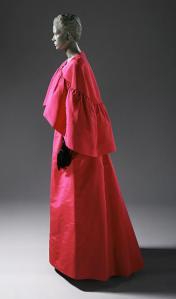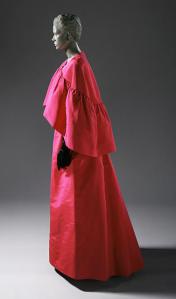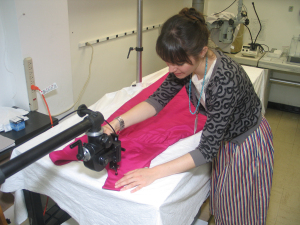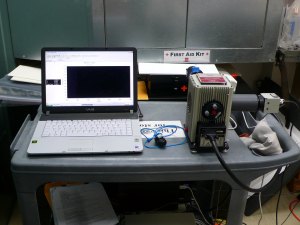Last week the DeYoung Museum in San Francisco opened Balenciaga and Spain. LACMA is contributing five gowns to the show, and it was my job to get them ready for their trip up north.
One of the LACMA-owned dresses in the exhibition is a bright pink silk evening gown with matching cape. Before sending it off, we wanted to know what would happen to the beautiful color while on view. We all know that overexposure to sunlight can be damaging to skin—well, it can harm fabric, too, causing its colors to fade. One way to test the light fastness of an object is to conduct a microfading test. The test uses a strong lamp and fiber optic cable to expose a miniscule area of the object (250 micrometers!) to a very strong ray of light. The exposure is measured, and the results are analyzed to determine how long an object can be illuminated before it begins to show signs of fading.
I tested the gown in several places and compared the results to standardized rates of fading known as the blue wool system. After analyzing the results we cautiously determined that the dress had been exposed to very little direct light in its lifetime (it is an evening gown after all), and can have a maximum exposure of 95,600 hours of UV filtered illumination. This means that in its lifetime the dress can be on display in a museum for 9,560 days, or 2.6 years, before there are perceptible signs of change. Fortunately, the dress will be exhibited in San Francisco for three months, with the lights on only during public hours.
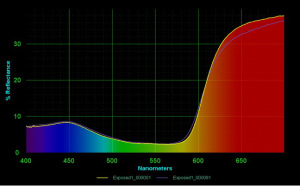
Spectrum depicting fading of colors; the lower curve is the faded curve. This graph shows that the reflectance of the red in the gown’s pink dye will fade the most over time, and the yellow and blue reflectance will increase in visibility.
Armed with this information we will be able to tailor the duration of each future exhibition period, thus ensuring its survival for many generations of museum visitors.
(Many thanks to Frank Preusser, Senior Scientist, Conservation, for his microfading tutelage and invaluable help with analyzing the test results.)



